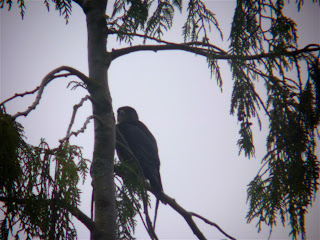Once you learn the names of the trees around you, your understanding of birds will increase. Your field notes will take on greater depth if you identify the trees where the birds are carrying out their activities. You may find, for instance that Winter Wrens are understory birds, not canopy birds. You might get Eureka moments such as these: "Hmmm, Bald Eagles tend to perch and nest in Cottonwoods in this region." "That's the third time I've seen Brown Creepers foraging for insects on on the main trunks of Douglas Firs." "Snags around here show excavations by Northern Flickers and Pileated Woodpeckers."
Of course, these are not 'laws' of fixed behavior. They are behavioral tendencies that will help you understand the ecosystem that sustains the bird.
Adult Bald Eagles in a Cottonwood
Lummi Reservation, WA
Below: Black Cottonwood
Populus trichocarpa
Below: Adult Bald Eagle at Edison, WA
The age of trees is also a factor in bird behavior. For instance, the Marbled Murrelet, a seabird, must nest atop old growth conifers, like the giant Douglas Fir shown below. Spotted Owls also depend on 'old growth'. This may lead you to question if changes in forest composition (by forestry, agriculture, and urbanization) will have an effect on these and other birds. Which birds are adapting to urban 'forests'? Which birds are failing to adapt? Your observations may help in long-term studies and conservation decisions.
You probably cannot estimate the tree's age, but you can tell its diameter. The bigger the diameter, the older the tree! Forest botanists measure the tree at four and a half feet above the ground, in centimeters (DBH: diameter at breast height). The old growth Douglas Fir, below, is nearly four meters in diameter at DBH! Since Douglas Fir tree rings are from 2 to 5 centimeters wide on the stumps I have seen, that makes the tree at least 400 years old. The lichen, Lobaria oregana, that I found near the tree, is another indicator of a mature or an old growth forest.
Lettuce Lungwort
Lobaria oregana
An indicator of old growth trees
Lobaria oregana
An indicator of old growth trees
Recognizing the trees and shrubs in your habitat will allow you to see patterns in avian behavior. You can relate this behavior to tree species with the five Ws: Who, What, Where, When, and Why. Look where birds spend most of their 'tree-time': the crown and upper canopy? the lower branches and understory? the forest floor? In the open? Do they prefer certain species for specific activities? Do they avoid certain species of trees? Does the maturity of the tree matter?
HERE ARE FIVE CONIFERS THAT SERVE AS BIRD HABITATS IN BELLINGHAM.
HERE ARE FIVE CONIFERS THAT SERVE AS BIRD HABITATS IN BELLINGHAM.
Above: Red Cedar
Thuja plicata
Above: Western Hemlock
Tsuga heterophylla
Above: Grand Fir
Abies grandis
Cones are upright, like all true firs
Above: Sitka Spruce
Picea sitchensis
Learn the trees and the web of life will not just be an abstract concept to you. For me, observing ecologically means:
- learning the habitats in this region.
- learning the plants (especially trees and shrubs) in those habitats.
- journaling species interactions, whether they be Boletus Mushrooms, Banana Slugs, Birch Trees, or Bushtits.
-using the 5 Ws: Who, What, Where, When, and Why.
If you would like to read more about old growth trees, I highly recommend the National Geographic October 2009 article called "The Tallest Trees: Redwoods".
-using the 5 Ws: Who, What, Where, When, and Why.
If you would like to read more about old growth trees, I highly recommend the National Geographic October 2009 article called "The Tallest Trees: Redwoods".
























